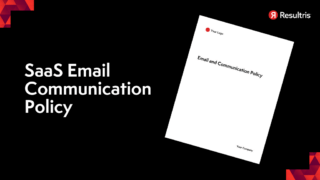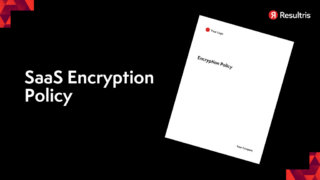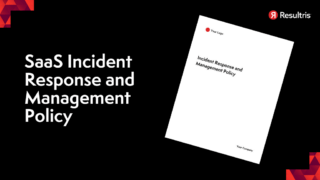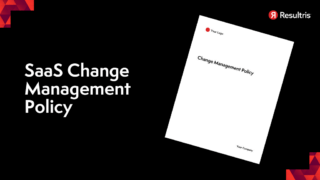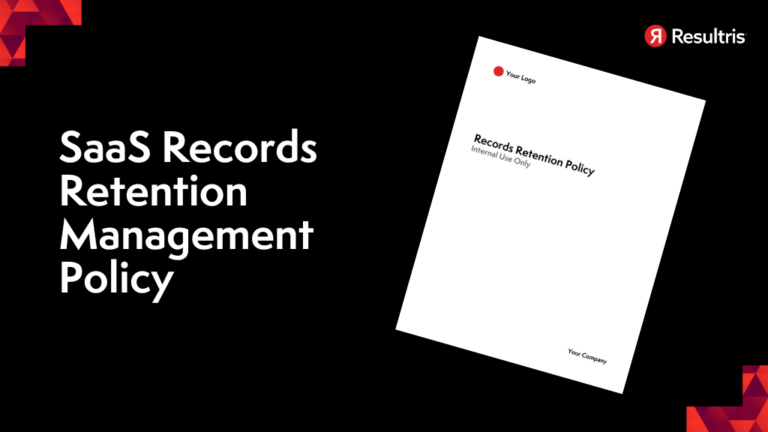
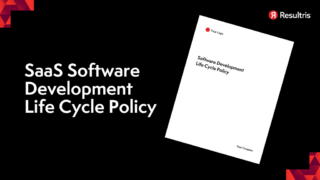
Written by: Tim Eisenhauer
Last updated:

Managing records efficiently is no longer a luxury—it’s a necessity. If you’re navigating the complex world of Software as a Service (SaaS), you’ll find that a robust records retention management policy is your lifeline.
But why is this policy so crucial, you ask? Imagine streamlining your operations, minimizing risk, and ensuring compliance—all with the help of a single strategy. That’s the power of effective records retention.
To help you get started, we’ll explore the ins and outs of a SaaS Compliance and Security Best Practices. Buckle up, because it’s time to dive into the world of SaaS records retention management.
As we dive deeper into the world of SaaS, let’s delve into the nitty-gritty of a SaaS Records Retention Management Policy.
A SaaS Records Retention Management Policy stands as a systematic plan that details how to manage and process documents throughout their lifecycle. It covers a range of operations— from the moment data enters the system up to its eventual destruction or archival. Besides, it plays an integral role in effectively managing risks and ensuring business continuity.
For SaaS companies, a well-defined records retention policy is pivotal. It aids in regulating how data gets managed within the cloud environment, thereby aligning with the best practices for SaaS data management. Moreover, it helps to maintain the integrity of data, prevent lost documents, and facilitate legal discovery procedures, making it crucial in underpinning a company’s operational effectiveness.
Data retention policies get significantly influenced by legal frameworks like the General Data Protection Regulation (GDPR). As part of the GDPR, companies should only retain personal data so long as it’s necessary for the intended purpose. Consequently, a robust data retention policy supports organizations in complying with these mandates, thus safeguarding against potential data breaches and hefty penalties.
Industry-based laws, like the Health Insurance Portability and Accountability Act (HIPAA) for the healthcare sector, and the Sarbanes-Oxley Act (SOX) for publicly traded companies, also spotlight the significance of meticulous record retention practices. SaaS companies catering to these sectors need a stringent policy in place to conform to such industry-specific regulations.
Nearly every region has unique data protection laws that impose constraints on the storage and disposal of records. For example, the California Consumer Privacy Act (CCPA) impacts not just Californian businesses but any entity with Californian clients. Compliance with these regional laws provides another compelling reason for SaaS companies to fine-tune their records retention policy and information lifecycle management.
In delineating a records retention policy for SaaS businesses, identifying key components becomes pivotal. This section encompasses various types of records, retention periods, and destruction procedures essential for a comprehensive policy.
Understanding the types of records to manage goes hand in hand with an effective records retention policy. Let’s break it down.
In your SaaS set up, customer data like usage statistics, account details, and payment information, all form integral parts of your records retention policy. Every interaction generates a record, imposing the need for careful data management.
Operational data – server logs, performance metrics, incident reports – forms the heart of your cloud data storage policy. It helps analyze system performance, troubleshoot issues, and drive key business decisions.
Document retention guidelines often emphasize business transactions, invoices, and expense reports. This financial data is essential not only for accounting purposes but also necessary for audit trails and regulatory filings.
From payrolls to performance reviews, employee data carries significant weight. It’s an essential facet of your records retention policy, ensuring compliance with labor laws and contributing to business transparency.
Retention periods are the lifeline of your SaaS Data Records Management Policy. Let’s analyze facets that influence it.
Several laws specify minimum retention periods for different record types. For instance, invoices must be kept for a certain period per tax regulations, while healthcare data under HIPAA has its own regulations. It’s important to be in sync with these legal mandates.
Every company has distinct needs. Whether you require records for trend analysis or long-term project audits, your business needs dictate your retention guidelines.
Understanding potential risks involved in data storage and retention is crucial. From data breaches to loss of confidentiality, risk assessment helps outline your retention strategies.
Post-retention, data relies on secure destruction procedures as a part of your information lifecycle management strategy.
Options range from digital wiping to physical destruction of storage devices. It’s paramount to incorporate secure data deletion methods in your policy to prevent unauthorized access or data breaches.
To prove adherence to regulations and demonstrate data liability management, destruction certificates serve a dual-purpose. It’s your documentary evidence of proper record disposal.
Mastering the art of SaaS record retention management is a strategy, a balancing act of sorts, where you’re aiming for the sweet spot between regulatory compliance and practical business requirements. Here, let’s carve out the steps for crafting your SaaS records retention policy.
Actively understanding your data forms the backbone of a sound records retention policy. Start by conducting a meticulous data inventory. Scrutinize all categories of data you handle – it could be customer information, employee data, transaction details, or operational statistics. The goal of this endeavor, besides gaining a comprehensive overview of your data landscape, is to categorize your SaaS data in a manner that aligns with regulatory standards and organizational needs.
One size doesn’t fit all when it comes to record retention deadlines. Creating a records retention schedule is the next logical step. Different types of records have disparate retention periods, set by laws, business use, or both. For instance, financial information might have a different retention period compared to customer data. You need to tailor your cloud data storage policy to specify how long individual record types ought to be retained, ensuring you’re not falling afoul of any legalities.
Success in SaaS data management hinges on establishing clear roles and responsibilities. Your IT department, for example, can oversee the technological facets of records management, while your legal team could ensure the policy complies with document retention guidelines. An HR representative might deal with employee data, and a dedicated records manager, if present, could orchestrate the entire records lifecycle. Remember, good records management is a group effort!
After painstakingly crafting your records retention policy, securing approval from key stakeholders becomes vital. Not just for getting the green light, but to ensure your policy aligns with the broader business strategy. Once the policy clears the approval stage, the implementation begins. This process encompasses educating the staff, integrating the policy into existing work processes, and establishing mechanisms for periodic review of the policy’s effectiveness. Information lifecycle management, to the finest detail, makes all the difference in successful SaaS data management.
As we zoom into the technical landscape of a records retention policy, there are several crucial components which are instrumental for effective SaaS data management. Let’s unpack these in detail.
Long-term document retention necessitates a storage strategy that is elastic, secure, and easily accessible. Here’s how this plays out in two different storage options.
With its flexibility and scalability, cloud storage emerges as an ideal solution for long-term data retention. It’s easy to maintain and expand, as you only pay for what use. Embracing cloud storage means data can be accessed from anywhere, making it a commendable pillar for your records retention policy.
Weighing on-premises against off-site storage is another crucial aspect of your data storage strategy. On-premises storage provides cause for excellent security control but might curb flexibility due the hardware limits. On the other hand, off-site storage garners ease of scalability but challenges data accessibility. Your final choice should reflect a fair balance of both security needs and efficiency requirements.
Make room for automation in your records retention policy. Implementing an Automated Retention and Destruction System mitigates the risk of manual errors, streamline your document retention guidelines and drastically cut down on manual labor. Remember, an efficiently automated system can be your robust defense against non-compliance penalties.
Organizing your data right from inception builds a solid foundation for a SaaS retention management policy. Data classification, paired with effective tagging can enhance the information lifecycle management. It bolsters data discoverability and accessibility – two traits indispensable for long-term retention and future audits.
Preserving data integrity and making sure your data is easily accessible remain critical under your records retention plan. Implement advanced encryption to protect your data from unauthorized access. Lean on data redundancy techniques to prevent data loss, while focusing on user-friendly interfaces for smooth data retrieval.
Ambitiously adopting these technical aspects, you’re equipping your business with a robust records retention management policy – one that’s prepared to turn challenges into opportunities.
While devising a SaaS Records Retention Management Policy, you’ll encounter various operational factors that need attention. The following sub-sections outline these aspects in detail.
Highlight in your SaaS data management approach is cultivating a culture of compliance among employees. How? By implementing a structured training program on records management. Employees grasp, via training, the protocol for handling and storing data. Additionally, they learn the relevance of document retention guidelines, legal implications of data mishandling, and the vital role they play in contributing to policy adherence.
Compliance isn’t just about formulating a well-drafted cloud data storage policy. It’s crucial to frequently audit and monitor the effectiveness of the records retention policy. By using internal audits, vulnerability assessments, or third-party audits, you can identify policy breaches, system vulnerabilities, and correct them promptly. Regular monitoring provides assurance of your policy’s effectiveness and boosts stakeholders’ confidence in your SaaS operations.
One of the challenging aspects of enforcing a records retention policy is managing litigation holds and legal requests. During a legal dispute or investigation, you might need to temporarily suspend your policy’s usual destruction process. Hence, it’s vital your policy includes provisions for such situations, outlining who manages them, the steps to take, and adequately documenting all actions.
SaaS company operations often span multiple jurisdictions. As a result, you must consider diverse, potentially conflicting regulatory requirements when crafting your information lifecycle management strategy. Your records retention policy must comply with the stringent data management laws within all jurisdictions you operate. This includes, but isn’t limited to, data storage, retrieval, transfer, and destruction processes.
An effective records retention policy goes beyond determining how long to store documents. It must also address the safeguarding of those records, particularly in a SaaS data management context. Let’s delve into those practices that guarantee data privacy and security: encryption, access control, and data modification.
Encryption is the cornerstone of data security. You’re not just storing records; you’re protecting sensitive information. Consider a cipher-based encryption method. For instance, AES-256 encryption, a military-grade cipher, transforms your records into unreadable data. Only with a correct decryption key can one access the original data.
Your records retention policy must define who has access to the records stored on your cloud data storage. Access controls and permissions can be as granular as needed. For example, specific teams or roles may only have access to specific record types. You can also implement tiered access, where higher-level roles have more permissions than lower-level roles, keeping access limited and under control.
Embracing data anonymization and pseudonymization techniques offers another layer of protection. These techniques restructure data, rendering single data points anonymous while keeping the data set useful. Anonymization makes the reverse engineering of data back to its original form impossible. Pseudonymization replaces identifying fields within a data record with artificial identifiers or pseudonyms. Use these techniques, particularly when dealing with personally identifiable information (PII) or sensitive health information, to ensure your company’s adherence to GDPR, HIPAA, and other regulations.
Information lifecycle management, indeed, demands vigilance. Your records retention policy is an essential tool that, when used wisely, minimizes risk and bolsters company-wide compliance.
The implementation of a robust records retention policy poses numerous challenges specific to the SaaS data management realm. Let’s uncover some of these complexities lurking beneath the cloud data storage policy execution.
Multi-tenant environments present unique issues in the SaaS Records Retention Management Policy space. These environments house data of multiple clients within the same architecture, increasing the risk of data mishandling, errors or cross-contamination. The categorization of client-specific data and segregation of access control parameters stand paramount for maintaining data integrity and confidentiality.
Additionally, the task of defining clear document retention guidelines can seem overwhelming in such settings due to the diverse nature and quantity of data. Balancing the need for data availability without compromising on secure data storage and privacy requirements forms a part of this uphill battle.
Another challenge arises when handling unstructured data – an inherent part of SaaS data landscapes. Often devoid of a formal structure or pre-defined model, unstructured data could include emails, text documents, presentations, or multimedia content.
Performing an information lifecycle management through such diversified data can appear to be an arduous journey, especially when it comes to categorizing data for retention. As this data grows exponentially, SaaS providers have to ensure they devise systems and strategies for efficient organization, search, and secure disposal, where necessary, without disregarding the concurrently stringent privacy legislations.
Enforcing data minimization principles while ensuring document retention might at times seem like a delicate trapeze act. After all, data minimization signifies eliminating unnecessary data while a records retention policy primarily focuses on preserving necessary information.
With regulatory compliance such as GDPR playing an instrumental role, SaaS providers have to juggle between retention requirements and data minimization principles in their data management practice. Striking a balance necessitates an in-depth understanding of the type of records to be retained alongside an awareness of data that warrants disposal post its relevancy period.
Implementing a SaaS Records Retention Management Policy can be a complex process but overcoming these challenges offers a pathway towards sustainable and compliant operations.
Let’s consider a few leading practices to bolster your SaaS records retention management policy.
Optimal records retention policy insists upon its regular review and updates. Legalities fluctuate, modifying the landscape of data compliance. Staying abreast of these changes protects your business from potential pitfalls. Review your document retention guidelines at least bi-annually, adding updates to ensure regulatory alignment.
For example, recently emerged data privacy regulations, such as GDPR, have introduced new rules for data retention. Regular reviews of your policy can enable a swift response to such changes, minimizing non-compliance risks and associated penalties.
Incorporating retention into information lifecycle management leads to healthier data practices. Data lifecycle management is all about governing data from its creation to eventual destruction. Embedding data retention factors at each of these stages ensures the clean, efficient management of records.
For instance, consider a SaaS Application like Dropbox. Dropbox manages a variety of data types across diverse user bases. Data lifecycle management envelops every step of data processing between creating a document to deleting it, ensuring compliance at all stages with its cloud data storage policy.
Enhance your SaaS data management by promoting collaboration across all business units. An isolated approach hampers the success of a robust records retention policy. Involve Legal, IT, and Business units in the policy formulation and implementation process, assuring that you cover all bases.
Take a law firm using a SaaS platform for document management as an example. The IT team ensures the technical compatibility of the platform, the legal team reviews the platform’s alignment with compliance regulations, and the business units ascertain its practical functionality. Formulating a records retention policy in unison bridges gaps, scales operational efficiency, and fortifies data safeguards.
Administering a records retention policy enhances your SaaS data management, especially in compliance with regulations like GDPR, HIPAA, and SOX. Let’s delve into the crafting and deployment stages of your policy with a phased approach, change management strategies, and positive communication with stakeholders.
A phased implementation of your records retention policy, rather than a complete overhaul, ensures a smooth transition. It commences with record type identification, ranging from employee records to financial documents. Following type identification, assigning appropriate retention periods to each record type forms the basis of your strategy. It’s essential to observe global document retention guidelines. Also, consider specific nuances within your business industry. Lastly, secure data destruction procedures must be clearly defined to avoid breaches in storing outdated or unnecessary data.
Change is good, but change management forms a critical part of any change initiative. It’s vital, particularly when revising or implementing changes to your cloud data storage policy. The success relies on engaging your workforce, refining their skill sets, and continuously monitoring the progress. It’s worthwhile to develop training programs or workshops to empower employees with the knowledge and skills required to adhere to the newly implemented policies.
An effective record retention policy isn’t just about formulating guidelines but also ensuring that your stakeholders, both internal and external, grasp its implications. Establish a comprehensive communication plan to deliver your policy. Train your team on the importance of the policy for information lifecycle management within SaaS. Notably, facilitate a shared understanding among your legal, IT, and business units. With a unified understanding, your team can significantly enhance the data management practices. At last, transparently communicate to your customers how their data will be managed and protected under the new policy.
Having established a robust SaaS Records Retention Management Policy won’t amount to much unless it’s effectiveness is regularly measured and improved. Therefore, consider the following mechanisms in maintaining and continually optimizing your records retention policy.
To drive efficiency in SaaS data management, fitting Key Performance Indicators (KPIs) become indispensable. KPIs help evaluate the actual impact of your records retention policy. For instance, a decline in data breach incidents or a faster document retrieval time can be considered positive outcomes of your policy. It’s important to define these indicators clearly, ensuring they’re tangible, quantifiable, and well-aligned with your business objectives.
Another method to gauge policy effectiveness is via compliance audits and assessments. Regular audits ascertain your alignment with regulations like GDPR, HIPAA, & SOX, as well as your own document retention guidelines. These audits, conducted both internally and by third-party auditors, serve as a reality check for your policy’s strengths and areas of improvement.
SaaS record management isn’t a static process. Keeping in tune with changes in regulation, technology, and business strategy, you should constantly revise and adapt your records retention policy. Continuous improvement processes, underpinned by feedback loops and corrective actions, significantly contribute to the sustainability and effectiveness of your cloud data storage policy. This commitment to evolve your policy provides a bedrock for superior information lifecycle management.
It’s fundamental to understand the legal and contractual considerations that shape your SaaS records retention management policy. Two significant areas of focus: customer agreements and third-party vendor management.
Your customer agreements play a pivotal role in shaping your records retention policy. They define the boundaries for how you manage and retain your client data. It’s important to incorporate clear data retention clauses that adhere to document retention guidelines provided by authorities such as GDPR, HIPAA, and SOX. Such clauses establish your obligations concerning data storage, access, protection, lifespan and disposal. They also protect customers’ rights in the realm of data privacy and protection.
Understanding your contractual obligations requires constant review. Varying client needs, changing technologies, and diverse geographical regulations make it crucial to revisit and revise your data retention clauses regularly. Be proactive, not reactive, in managing customer data.
A well-thought-out SaaS records retention management policy must extend beyond your internal operations. You’re likely to engage third-party vendors, particularly when it comes to cloud data storage. As part of efficient SaaS data management, it’s crucial to ensure vendors abide by your policy and meet document retention guidelines.
Critical aspects to consider include the security measures they have in place, their data recovery processes, and how they adhere to laws governing data storage and retention. Vigilant vendor management can save you from potential breaches and legal repercussions. After all, outsourced tasks don’t absolve you of accountability.
Data is an asset, yet, if not managed properly, it can turn into a liability. E-discovery underscores the legal aspect of SaaS data management. It’s the process of identifying, preserving, collecting, and providing electronic information necessary for potential litigation.
Effectively managing information through its lifecycle keeps you one step ahead. It ensures you can satisfy any legal requests promptly, minimizing the risk of non-compliance or sanctions. An agile, well-documented retention policy assists in identifying and retrieving the necessary data efficiently. E-discovery readiness keeps you confident in your ability to meet any legal challenge.
Just remember: a comprehensive legal approach to records retention isn’t a one-and-done task. It requires ongoing vigilance and amendment to stay current, resilient, and compliant in a rapidly evolving SaaS landscape.
In the ever-evolving world of SaaS data management, it’s essential to keep a finger on the pulse of industry trends. The landscape of records retention policy is no exception, with AI, blockchain, and edge computing shaking up traditional document retention guidelines.
Organizations are embracing Artificial Intelligence (AI) and Machine Learning (ML) to enhance their records retention policies. AI applications streamline complex processes, reducing the time and resources dedicated to data management tasks. They assist in identifying records eligible for disposal or archival, ensuring compliance with retention schedules. AI and ML aren’t just added benefits – they’re becoming increasingly crucial to staying competitive in the crowded cloud data storage policy environment.
Blockchain technology offers a fresh approach to record keeping. With its inherent immutability, a blockchain network provides verifiable and permanent record maintenance, vital for crucial documents that require long-term storage. Blockchain’s decentralized structure offers substantial security enhancements, resistant to both internal and external risks that may compromise data. For a firm grasp of information lifecycle management, considering blockchain’s benefits isn’t just savvy – it’s necessary.
Edge computing impacts data retention practices by processing data closer to its source. This offers boosted speed and reduced latency, enabling real-time processing and analysis. Edge computing affects your data’s lifecycle – from creation and usage to archival and disposal. Adapting your records retention policy to leverage the benefits of edge computing isn’t an option – it’s an expectation. In conclusion, evolving trends are reshaping the landscape of record retention, rendering technology a valuable ally in data management, not to overlook the possible challenges.
Striking a balance between business requirements and compliance with document retention guidelines is pivotal. It’s crucial to perform a cost-benefit analysis, approach risk management strategically, and align retention policies with your business strategy.
When thinking about SaaS data management, you might question, “How long should our company keep records?” The cost-benefit analysis of long-term data retention has to be your first step. For instance, cloud data storage policy may prove to be a significant expense in the long run, especially for large volumes of data. On the one hand, extra data can provide business benefits – historical records offer valuable insights for future tactical decisions. On the other hand, there are both direct costs, such as storage and management fees, and potential indirect costs, such as liability due to outdated or unnecessary data.
A robust records retention policy allows for effective risk management. Retaining records beyond their useful business or legal timeframe presents an unnecessary risk. For example, if you retain customer data that you no longer need, and that data is breached, you risk financial penalties, reputational damage, and potential lawsuits. Conversely, failure to retain data long enough could lead to non-compliance with regulations like GDPR, HIPAA, and SOX.
The alignment of your retention policies with your business strategy is a key aspect of information lifecycle management. Remember, these policies shouldn’t be set in stone; rather, they must adapt to shifts in business strategy, industry regulations, and technological advancements. After all, in today’s fast-paced SaaS landscape, change is the only constant. From AI integration to blockchain technology – you must ensure that your retention policies are flexible enough to accommodate these transitions, streamlining operations while ensuring compliance.
In this section, we explore several scenarios involving SaaS data management that draw attention to the practical aspects of a records retention policy.
Closing customer accounts triggers a crucial juncture in information lifecycle management. Once an account is closed, you must secure, isolate, and prepare the user’s records for disposal unless specified otherwise by retention guidelines. Also, ascertain that backups containing the user’s data are handled in line with the closure procedure, ensuring tidiness and order in your cloud data storage policy.
In terms of trial users, it’s imperative to define a stringent document retention guideline. A common misconception is that trial user data, given its transient nature, holds less value. This is far from the truth. Trial user data contributes significantly to your understanding of customer behavior, and hence, it requires robust management. Your records retention policy decides the longevity of the trial user data post their tenure and impacts the growth analytics significantly.
System logs and metadata retention require mindful decisions. System logs reveal crucial insights and aid in bug tracking, security management, performance diagnosis, and more. Simultaneously, these must be weighed against storage and management costs. It’s important to design a balanced records retention policy, encompassing the cost-effective, yet efficient strategy in retaining these invaluable parts of your SaaS data management plan.
In your SaaS Records Retention Management Policy, a solid disaster recovery and business continuity plan plays an essential role. This section aims to enlighten you about efficient backup strategies, guaranteed data availability, and feasible recovery time objectives.
Proactive backup strategies can be your fortress against data loss. Formulating a comprehensive backup approach for retained records falls under the purview of sound SaaS data management. Regular data backups, preferably automated, ensure that your business doesn’t lag. Consider three types of backups: full, incremental, and differential. Full backups involve backing up the entire data, incremental backups store changes made post initial backup, and differential backups consider alterations since the last full backup.
| Type | Description |
|---|---|
| Full | Backs up entire data |
| Incremental | Stores changes post initial backup |
| Differential | Considers changes since last full backup |
Adapting a mix of these strategies, conditional on the type of data and its frequency of change, proves beneficial for a reliable records retention policy.
Disasters might hit you unanticipated. However, your document retention guidelines must encompass a well-devised catastrophic plan to ensure around-the-clock data availability. Cloud data storage policies aid in keeping the system resilient despite unforeseeable disruptions. Multiple data centers across various geographies promote data replication while reducing the possibility of simultaneous outage.
Creating core data subsets, often called ‘golden records’, serves as a respite during such calamities. These minimal viable datasets can power your most critical functions, ensuring business continuity even in the face of adversity.
Determining recovery time objectives (RTOs) forms a critical part of information lifecycle management. Any delay in restoring critical data can severely impede your business operations. The RTO for archived data should be in line with your recovery point objective (RPO), defining the age of files that must be recovered for normal operations to resume.
For instance, if your RPO is one day, the backup system should contain all data up to one day ago. An equally stringently defined RTO ensures that your business is up and operational with minimal disruption during a disaster. Remember, defining the right balance between RPO and RTO is key – too tight, you might overspend on backups; too loose, and you might lose crucial data.
Irrevocably, expertly defined and followed SaaS Records Retention Management Policies ease data recovery and promote business continuity, forming a steadfast shield against any unplanned disasters.
Sometimes, beyond regulatory imperatives, ethical dilemmas become part of the records retention policy. Here, we’ll hone in on aspects of transparency with customers, the right to be forgotten, and the environmental impact of data storage.
Transparency signifies your respect for customers’ data rights. It sends a clear message about your commitment to the secure handling of their personal data. Deciding what data to retain and for how long, lies at the core of a SaaS data management. A customer-centered approach necessitates that you communicate these document retention guidelines clearly. It’s a great opportunity to build trust and foster long-term relationships if the policy showcases a balance between business needs and respect for customers’ privacy.
Ever wondered how to reconcile customers’ right to be forgotten with regulatory requirements for data retention? Compliance with regulations such as GDPR (General Data Protection Regulation) necessitate respecting users’ requests to erase their information. Yet, certain records might need to stay within your storage based on sectorspecific regulatory mandates. It implies that an effective records retention policy strikes a balance between these two, making it a fine act of ethical judgment.
Lastly, though often overlooked, is the environmental aspect of storing data. Yes, virtual cloud storage also has a real-world footprint. It might not be immediately evident, but data centers around the globe consume significant energy. Hence, supporting sustainability through mindful data storage becomes an ethical consideration in information lifecycle management. It’s about making conscious decisions – from choosing energy-efficient technologies to periodic data cleanup – all contributing to reducing the environmental impact of long-term data storage. Going green is not just good for the planet, it’s an ethical sound business choice too.
So, you’ve seen how a robust SaaS Records Retention Management Policy can streamline your operations, minimize risk, and ensure compliance. You’ve learned about the nuts and bolts of policy creation and the unique challenges of SaaS data management. You’ve also delved into the ethical side of data retention, understanding the importance of transparency, respect for customer data rights, and eco-conscious data storage. Remember, it’s crucial to align your retention policy with your business strategy, stay abreast of cutting-edge trends like AI and blockchain, and manage the risks of long-term data retention. By doing so, you’ll be well-equipped to navigate the ever-changing SaaS landscape.
Disclaimer
Please note that the information provided in this blog post is for informational purposes only and does not constitute legal advice. We are not lawyers, and reading this content does not create an attorney-client relationship. For legal advice specific to your situation, please consult with a qualified attorney.

